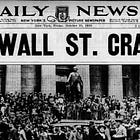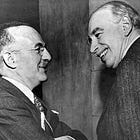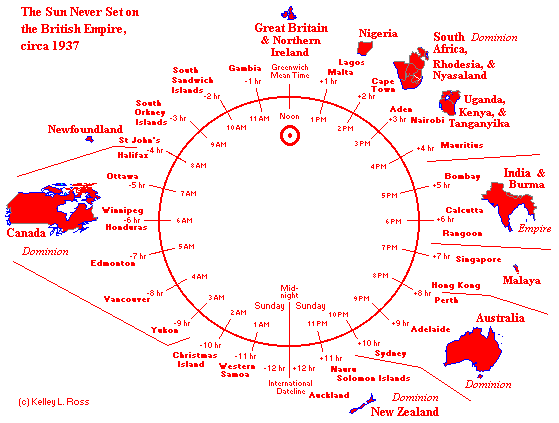The First British Empire ruled with gunpowder and garrisons. The Second perfected divide and conquer — playing rivals off each other to maintain global leverage.
The Third British Empire1 — still with us — swapped bayonets for banknotes. It reframed control in the language of financial aid, global cooperation, and social justice. Power moved, not to Parliament, but to the Royal Institute of International Affairs2 and other elite think tanks3, and the global financial institutions they helped create4.
The First British Empire5, spanning the late sixteenth to early eighteenth century, was built through military conquest, naval supremacy, and direct colonial control — an era of guns and bullets. British power expanded through annexation, settler colonies, and trading outposts, often under the aegis of state-chartered monopolies like the East India Company6. It was the age of mercantilist extraction, where empire meant armed enforcement, slavery, and trade dominance — an outward surge of force-backed control.
The Second British Empire7, rising after the 1783 loss of the American colonies, marked a shift from direct rule to strategic orchestration. Rather than seizing territory outright, Britain managed the global balance of power — effectively playing rivals against each other through treaties, alliances, and financial leverage. Naval dominance still mattered, but influence increasingly replaced occupation. Access and advantage were secured through informal empire, economic entanglement, and diplomatic manoeuvring. Real power now lay not in red maps, but in London’s quiet ability to set the rules from afar.
The Third British Empire represents a deep structural shift: the transition from colonial rule and diplomatic statecraft to a far more abstract — but no less potent — architecture of economic and epistemic control. Gone were the red lines of empire and the backroom treaties of great powers; in their place emerged a latticework of financial infrastructure, regulatory blueprints, and institutional planning through which influence could flow without flags. Power no longer resided in gunboats or foreign offices, but was being rerouted into currency regimes, monetary stabilisation schemes, and the early scaffolding of international economic governance. London, far from retreating, repositioned itself as the centre of a system where decisions would soon be encoded into market logic, technical standards, and expert consensus.
At the centre of this recalibration was the Royal Institute of International Affairs (RIIA), also known as Chatham House — a quiet powerhouse where the language of empire was reconstituted into the idiom of global coordination, economic planning, and cooperative internationalism. Founded in 1920 as an imperial think tank for the post-war world, the RIIA became the blueprint factory for a new form of influence: one based not on territory or force, but on intellectual preeminence, elite networks, and long-range strategic planning. It was here — not in Parliament or the Palace — that the core logic of the Third Empire was formulated: through white papers, research memoranda, and technocratic circles that began reshaping the post-imperial order into a managed, rules-based global system.
This third iteration of empire did not yet operate through Digital Twins or surveillance data indicators. But its foundations had been laid. It spoke, even then, in the language of duty and responsibility — stability, reform, global welfare — while embedding itself in monetary design, and institutional templates. The empire remained, though it had changed form: its enforcers were no longer soldiers, but economists.
The intellectual foundation of the Third British Empire was consequently not laid in government chambers or royal courts, but in elite strategy circles that sought to transcend the constraints of traditional state power. Central to this transformation were figures like Alfred Zimmern8 and Lionel Curtis9, who understood that the age of overt empire was ending — not because ambition had waned, but because its logic had to evolve. In The Third British Empire10 (1926), Zimmern argued that British influence should persist not through territorial control, but by embedding its norms, personnel, and institutional grammar within emerging systems of international governance. Crucially, he framed this transformation as a moral endeavour — an obligation to guide global cooperation through education, administration, and law. For Zimmern, the future of empire was not conquest, but conscience: a civilisational project justified by international social justice, ethical leadership, and the promise of global welfare. This shift in rhetoric — from domination to alleged responsibility — helped recast imperial strategy as enlightened stewardship, preparing for a world in which power could be exercised invisibly by the elite.
Curtis, for his part, envisioned a federal world order emerging from the imperial commonwealth11 — an association of self-governing states bound not by conquest, but by shared legal and administrative norms. Together, Zimmern and Curtis charted a strategic metamorphosis: empire would no longer govern by edict, but by architecture. Their legacy was not symbolic but structural. They co-founded Chatham House12 (RIIA) which as a central nerve centre of this post-imperial reconstitution13 did not itself wield executive power, but rather trained the elites, shaping long-range policy, and drafting the intellectual scaffolding for the new forms of international order emerging through institutions like the League of Nations14.
What defines the Third British Empire is this deliberate shift of authority — from sovereign states to networks of experts, economic planners, and technocratic forums. Leonard S Woolf’s International Government15 (1916) offered one of the clearest early blueprints for this model: a functionalist order administered by international organisations — specialised agencies, operating outside of democratic capacity. That logic — rule by technocrats — was already shaping international thought by the mid-1930s. Chatham House and its transatlantic peers became early laboratories for this shift, embedding British strategic DNA into the conceptual architecture of what would soon become a new global order. The empire consequently did not end — it changed form, and continued to operate through a framework, deeply embedded in the global organisations gradually taking shape.
This transformation — from imperial governance to global functionalism — was no accident. It was the conscious work of strategists who saw that influence in the twentieth century would depend on organisational design. Zimmern, Curtis, and Woolf laid the conceptual blueprint: supranational agencies insulated from democracy, federated legal norms beyond state sovereignty, and a global architecture animated by British institutional grammar. Their ideas found early form in the League of Nations and would later shape the postwar order — supposedly not as colonial, but institutional rule.
The League of Nations offered a first glimpse of the new governance logic in institutional form: not dominion over nations, but coordination between them. Its architecture reflected core British strategies — mandate systems, advisory committees, and norm diffusion — designed less to enforce than to embed. Though the League lacked coercive power, it legitimised global authority through expertise, legalism, and administrative continuity. Crucially, its creation catalysed the birth of a wider ecosystem of international bodies, including the International Labour Office and the International Research Council16, which later evolved into the International Council of Scientific Unions17 (ICSU). These institutions extended the League’s functional logic — governance through specialisation, insulated from popular will — in each their own specialised capacity.
By the mid-1930s, the defining features of the Third British Empire were already in place: sovereign decision-making was being displaced by expert consensus; formal colonialism had given way to informal institutional control; and global politics was being reframed as a matter of ethical management, framed around social justice. The full machinery of global governance would not be constructed until after the Second World War, but its blueprint was already drawn. The logic was clear: empire would endure — but in a vastly different shape.
The next major step came in 1930 with the creation of the Bank for International Settlements (BIS), established through the Dawes and Young Plans as a mechanism for managing German reparations. But its deeper function soon became clear: the BIS would serve as a discreet hub for central bank coordination — an early cornerstone in the architecture of transnational economic governance. While the League laid the normative and institutional groundwork, the BIS began embedding financial control into the very structure of international order.
Meanwhile, the steady marginalisation of the British monarchy unfolded alongside the rise of the Third British Empire’s technocratic architecture. Once the sovereign hub of imperial command, the Crown’s authority was gradually eclipsed — first by parliamentary supremacy, then by the emergence of administrative and financial systems that no longer required royal assent. By the interwar period, power had begun to shift decisively from royal prerogative to institutional expertise. Influence migrated not to monarchs, but to policy elites operating through bodies like the RIIA and the BIS, where decisions were increasingly framed in terms of technical coordination.
This was no incidental development. Neither Curtis nor Zimmern saw a future in which the monarchy retained executive power. Their federalist and functionalist blueprints left little room for kingship: legitimacy was to derive from systemic performance, not hereditary line. For Curtis, the monarchy retained ceremonial value — a kind of constitutional quasi-mascot — but Zimmern saw no place for such ‘absurdities’ at all.
The eclipse of royal authority reveals the deeper logic of the Third Empire: its genius lay not in visible command but in invisible architecture. British strategic thinking was not discarded — it was abstracted, refined, diffused, and embedded into the institutional fabric of international governance. The empire’s future would be secured not by crowns or colonies, but by expert committees, surveillance data indicators, and rules-based regimes. While the flag receded, the strategic framework endured.
By the time Keynes published The General Theory18 in 1936, the architecture of the Third British Empire was already taking shape — not through territorial expansion, but through intellectual and institutional influence. The old instruments of imperial power — flag, fleet, monarchy — were being replaced by the capacity to define the frameworks of recovery, cooperation, and economic management. Keynes’s intervention was not just about economic policy. It marked a civilisational shift toward systemic coordination, where the state’s role was redefined through the lens of managed demand and macroeconomic equilibrium.
But Keynes did not emerge in isolation. His work aligned with — and was enabled by — a broader strategic effort already underway within British elite institutions. By the early 1930s, the RIIA published a series of policy blueprints — The International Gold Problem19 (1931), Monetary Policy and the Depression (1933), and The Future of Monetary Policy20 (1935) — which effectively outlined the coordinated fiscal and monetary framework that Keynes would later formalise in The General Theory. These reports, in dialogue with central bankers at the newly established Bank for International Settlements, argued for the abandonment of the gold standard, the synchronisation of national policies, and the proactive use of active tools like open market operations — long before such ideas became politically mainstream.
Curtis and Zimmern understood that formal empire could no longer sustain British influence, but that its governing logic — administrative coordination, legal standardisation, and elite consensus — could be preserved through institutional design. Their answer was reinvention: to embed British strategy into the very architecture of global governance. Long-term planning would be delegated to the Royal Institute of International Affairs (RIIA), while the Fabian Society would oversee the gradual implementation of policy through civil society organisations and bureaucratic channels, such as the Labour Party when in power. Keynes’s work fit seamlessly into this larger project; The General Theory gave political and intellectual cover to what had already been engineered — an architecture that politicised economics, relying on central bank coordination, deficit-financed stimulus, and international frameworks designed to displace sovereign discretion.
Rather than revolutionising economic thought, Keynes thus helped institutionalise a model already under construction — one that redefined economic management as a permanent function of central planning. And while The General Theory is remembered as the intellectual turning point, the actual transformation was operational even earlier: drafted in committee rooms, circulated through policy memoranda, and tested in the crucible of interwar crisis.
From this prewar foundation, the postwar economic order was finalised. The interwar crises justified the need for new tools — what changed after 1944 was the institutionalisation of those tools within binding global frameworks. The International Currency Experience21 and its companion reports were less diagnosis than design documents, proposing an operational model that was soon embedded in global institutions.
At Bretton Woods, that design became policy. Although Keynes’s proposal for a global clearing union was rejected, the resulting institutions — particularly the IMF and World Bank — reflected the strategic logic developed at Chatham House: stabilised exchange rates, constrained capital flows, and coordinated stimulus under expert management. These were not merely economic policies, but instruments of supranational control, through which national governments would increasingly operate within boundaries they crucially did not themselves set.
The only missing piece was full coordination of domestic economic policy. But as Leonard Woolf outlined in International Government (1916), that coordination would follow inevitably through what we now call neoliberal trade policy. With the removal of tariffs and the liberalisation of labour and capital flows, national economic frameworks would gradually align across borders out of economic necessity. It was only a matter of time — and that was precisely the trajectory the IMF began promoting from its inception. By the 1990s, this agenda had gained full traction, with figures like Lawrence Summers, Alan Greenspan, Paul Krugman, Jeffrey Sachs, Joseph Stiglitz, Frederick Mishkin, and Robert Rubin all aggressively advancing the neoliberal model across the West.
Thus, this was not a return to empire in its classical form, but the continuation of its strategic logic by other means. Concepts like peace, equity, and reconstruction were used to legitimise a system whose true innovation lay in shifting control from territorial administration to institutional constraint — framed as international social justice and implemented through promises of development, yet always tied to conditions outside the control of recipient nations. National governments still formally exercised authority, but increasingly within parameters defined elsewhere: at Bretton Woods, in Basel, and across the emerging international organisations headquartered in Geneva and New York.
With the establishment of the United Nations in 1945, the transition was effectively complete. Imperial power was not handed to a rival state, but diffused across a global system built on British administrative principles and sustained by a transnational network of technocratic institutions. And as power flowed from London to Washington, the apparatus of global governance moved from design to deployment. The Third British Empire was largely British in name only, while the organisations entrusted with long-term planning were doing so outside the influence of democratically elected representatives.
Metamorphosis Complete
The transition marked not an end, but a climax. As the locus of enforcement shifted decisively from London to Washington after 1945, the apparatus of global governance — meticulously designed within British elite circles, imbued with British strategic logic, and embedded with British administrative DNA — moved irrevocably from blueprint into global operation. The Third British Empire was never about continued British command. Its defining achievement was the successful transplantation of an imperial governance model — reframed in the language of cooperation, stability, and international social justice — into the very foundations of a new supranational order.
Power no longer resided in a single imperial capital, but in the system itself: a web of technocratic institutions (IMF, World Bank, UN agencies, later WTO), financial regimes, and expert networks. These structures, born from interwar British strategic thought, operated on principles fundamentally at odds with democratic accountability. Long-term planning, economic frameworks, and the rules governing global interaction were increasingly formulated outside the sphere of sovereign deliberation, entrusted instead to:
Central Bankers, coordinating through the BIS and later networks;
Technocrats and Economists within international financial institutions (IFIs);
Elite Policy Networks and Think Tanks, shaping consensus beyond public mandates;
Supranational Committees, setting standards and conditions detached from national electorates.
The ‘British’ in ‘Third British Empire’ signifies its intellectual and institutional provenance — not its contemporary ownership. Britain provided the vision, the architecture, and the specific logic of control — prioritising financial leverage, expert management, and institutional constraint — into the operating system of the postwar world. Once deployed, this system acquired its own momentum and custodians, but always functioning according to the undemocratic, managerial logic its British architects envisioned.
The empire did not fall; it dissolved into the infrastructure. Sovereignty became a facade, veiling a deeper reality: governance by unelected consensus, where power flows through conditional loans, credit ratings, technical standards, and the quiet authority of the spreadsheet. The ‘Third British Empire’ endures not as a nation’s dominion, but as the systemic legacy of imperial strategy reborn as global technocracy — British in origin, transnational in operation, and… profoundly undemocratic in essence.
To be continued.
Keep reading with a 7-day free trial
Subscribe to The price of freedom is eternal vigilance. to keep reading this post and get 7 days of free access to the full post archives.
















